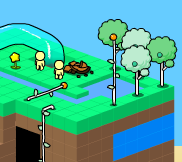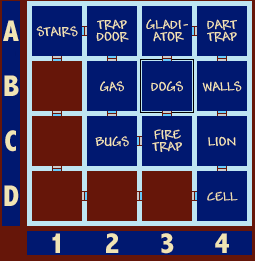I think many of us in the puzzle world tend to underestimate how much of an impact thematic choices can have on the way a puzzle is solved. Today we’ll discuss two games (the first is really a series of games) whose underlying mechanics are logically very similar, but whose cosmetic differences significantly alter how the solver tackles them.
 First up is Grow, an increasingly large set of puzzle games by ON. You may be familiar with these games already, as they’re rather popular in the casual gaming scene. (Heh.) The general idea is that you have a set of items which must be added to the playing field in a certain order. After each item is added, previous items can “level up” and interact with each other in certain ways. The goal is to choose the one correct order (though sometimes there are several), at which point… something will happen. It’s usually up for you to determine what the goal really is, and to figure out how the items interact.
First up is Grow, an increasingly large set of puzzle games by ON. You may be familiar with these games already, as they’re rather popular in the casual gaming scene. (Heh.) The general idea is that you have a set of items which must be added to the playing field in a certain order. After each item is added, previous items can “level up” and interact with each other in certain ways. The goal is to choose the one correct order (though sometimes there are several), at which point… something will happen. It’s usually up for you to determine what the goal really is, and to figure out how the items interact.
 Adam Cadre’s Lock & Key (Java version here), my absolute favorite single puzzle in an IF game (don’t worry if you haven’t caught up on IF yet; most typical IF conventions are eschewed for this one anyway), plays on a very similar mechanic. You are, after a short introduction (if you’re stuck here, see the first comment for a spoiler), charged with constructing a 4×4 dungeon from which no man can escape. You have at your disposal a variety of traps to place in the fourteen empty rooms, but it’s up to you to figure out which ones and, more importantly, what order. Once your blueprints are complete and the dungeon is constructed, all you can do is sit back while Boldo the Brave, an adventurer with serious grievances against your employer, attempts to escape from your masterpiece.
Adam Cadre’s Lock & Key (Java version here), my absolute favorite single puzzle in an IF game (don’t worry if you haven’t caught up on IF yet; most typical IF conventions are eschewed for this one anyway), plays on a very similar mechanic. You are, after a short introduction (if you’re stuck here, see the first comment for a spoiler), charged with constructing a 4×4 dungeon from which no man can escape. You have at your disposal a variety of traps to place in the fourteen empty rooms, but it’s up to you to figure out which ones and, more importantly, what order. Once your blueprints are complete and the dungeon is constructed, all you can do is sit back while Boldo the Brave, an adventurer with serious grievances against your employer, attempts to escape from your masterpiece.
The way one solves Grow is usually fairly simple, at least at first: the objects rarely seem to have anything to do with each other, so you try an ordering at random, then move forward and backward in your permutation those items which “grew” too soon or too late. As this happens you start to notice connections between certain pairs of elements, and as you fuss with the order through trial and error, you eventually get it right.
With Lock & Key, the expectations and reactions are almost reversed. Seeing the traps available to you, it’s hard to imagine that your first attempt would be anything but a resounding success. However, Boldo is a remarkable adventurer (he seems to be some sort of multiclassed wizard-bard-rogue-monk). Your first several times setting it up, he’ll likely get through without so much as a scratch. Whereas in Grow you find yourself surprised when seemingly disparate elements work together, here you’ll be amazed at how catastrophically your ostensibly impenetrable maze falls apart. This is, ultimately, why I like it better as a puzzle: because the losses are just as informative as the successes. And when Boldo finally expires in your dungeon, I promise it’ll be immensely satisfying.
(And of the seven Grow games linked above, Grow RPG is my favorite. It’s no coincidence that this is also the version which is most similar to Lock & Key.)
The point of Lock & Key is the main puzzle. The introduction is meant to be short, so if it’s not (which is entirely possible for those new to IF), here’s the solution in ROT-13. Translate here.
RKNZVAR SYBBE. GNXR ZRGNY. TVIR ZRGNY GB THNEQ.
Well, Jonah. I have something to occupy my time for today!